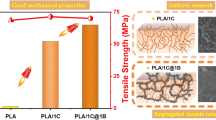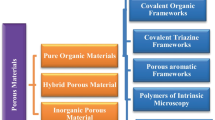Abstract
Polymer nanocomposite has been proven to improve the property of polymer salt complex. Organo-modified clay and inorganic oxides are the most commonly used filler for polymer nanocomposite (PNC). However, single wall carbon nanotube (SWCNT)/multiwall carbon nanotube (MWCNT) are becoming popular filler for PNC for their high surface area and high mechanical stability. In this work, a series of PNC sample has been prepared by using polyethylene oxide (PEO)-polydimethylsiloxane (PDMS) blend as polymer matrix, an optimized salt stoichiometry of Ö/Li ~15, and surface-modified MWCNT as filler. The effect of ion-polymer and ion-MWCNT interaction in the polymer nanocomposite has been investigated by using XRD, SEM, FTIR, and electrical study. X-ray diffraction pattern confirms the dispersion of MWCNT inside the polymer chain and modifies the structural parameter of the polymer matrix. FTIR spectra indicate inclusion of MWCNT inside the polymer salt complex which changes the ion dissociation/association in the polymer host matrix. Further, the changes in structural, thermal, and electrical property of the polymer salt complex system have been studied by using SEM, DSC, and impedance analysis. Dc conductivity study shows that optimized PNC sample has conductivity of 8.04 × 10−5 S cm−1. This is almost two order enhancement from pure polymer salt system (10−6 S cm−1).










Similar content being viewed by others
References
Bruce PG, Vincent CA (1993) Polymer electrolytes. J Chem Soc Faraday Trans 89(17):3187–3203
Forsyth M, Sun J, Macfarlane DR, Hill AJ (2000) Compositional dependence of free volume in PAN/LiCF3SO3 polymer in salt electrolytes and the effect in ion conductivity. J Polymer Science: Part B Polymer Physics 38:341–350
Kumar PN, Sasikala U, Sharma AK (2013) Investigations on conductivity and discharge profiles of novel (PEO+PMMA) polymer blend electrolyte. International Journal of Innovative Research in Science, Engineering and Technology 2(80):3575–3582
Kulasekarapandian K, Jayanthi S, Muthukumari A, Arulsankar A, Sundaresan B (2013) Preparation and characterization of PVC–PEO based polymer blend electrolytes complexed with lithium perchlorate. International Journal of Engineering Research and Development 5(11):30–39
Ibrahim S, Yasin SMM, Ng MN, Ahmad R, Johan MR (2011) Impedance spectroscopy of carbon nanotube/solid polymer electrolyte composites. Solid State Commun 151:1828–1832
Saxena H, Bhattacharya B, Jadhav NA, Singh VK, Shukla S, Dubey M, Singh PK (2014) Multiwall carbon-nanotube-doped ion conducting polymer electrolyte for electrochemical application. J Exp Nanosci 9(5):444–451
Ahn JH, Kim YJ, Wang GX (2006) Electrochemical properties of carbon nanotube-dispersed PEO-LiX electrolyte. Met Mater Int 12(1):69–73
Tang C, Hackenberg K, Fu Q, Ajayan PM, Ardebili H High ion conducting polymer nanocomposite electrolytes using hybrid nanofillers. Nano Lett. doi:10.1021/nl202692y
Sharma AL, Thakur AK (2010) Polymer–ion–clay interaction based model for ion conduction in intercalation-type polymer nanocomposite. Ionics 16:339–350
Lee JY, Bhattacharya B, Kim DW, Park JK (2008) Poly(ethylene oxide)/poly (dimethyl siloxane) blend based solid polymer electrolyte and its dye synthesized solar cell applications. J Phys Chem C 112:12576–12582
Ramesh S, Liew CW, Morris DR (2010) Effect of PVC on ionic conductivity, crystallographic structural, morphological and thermal characterizations in PMMA–PVC blend-based polymer electrolytes. Thermochim Acta 511:140–146
Saddun NN, Subramaniam R, Kashi R (2014) Development and characterization of poly(1-vinylpyrrolidone-co-vinyl acetate) copolymer based polymer electrolytes. The scientific world: 254215
Chaurasia SK, Saroj AL, Shalu SVK, Tripathi AK, Gupta AK, Verma YL, Singh RK (2015) Studies on structural, thermal and AC conductivity scaling of PEO-LiPF6 polymer electrolyte with added ionic liquid [BMIMPF6]. AIP Adv 5:077178
Yoshihara T, Tadokoro H, Murahashi S (1964) Normal vibrations of the polymer molecules of helical conformation. IV. Polyethylene oxide and polyethylene-d4 oxide. J Chem Phys 41:2902
Kan K, Liu Y, Tian Y, You Q (2013) Study of P(VDF-HFP)/CNTs composite microporous polymer electrolyte for li ion battery. International Journal of Chemical Engineering and Application 4:42–45
Acknowledgements
The authors are very much thankful to Central Research Facility, IIT Kharagpur, India and Department of Physics, IIT Patna for providing the necessary research facility for carrying out the research.
Author information
Authors and Affiliations
Corresponding author
Rights and permissions
About this article
Cite this article
Das, A., Thakur, A.K. Effect on ion dissociation in MWCNT-based polymer nanocomposite. Ionics 23, 2845–2853 (2017). https://doi.org/10.1007/s11581-017-2171-1
Received:
Revised:
Accepted:
Published:
Issue Date:
DOI: https://doi.org/10.1007/s11581-017-2171-1




